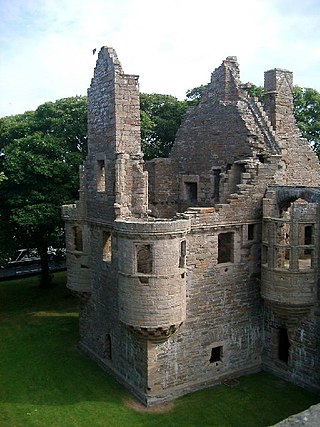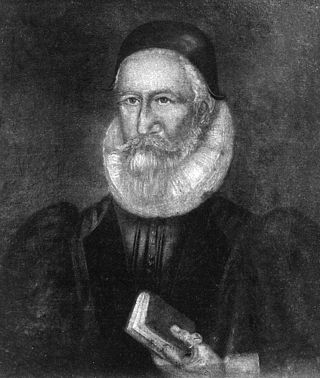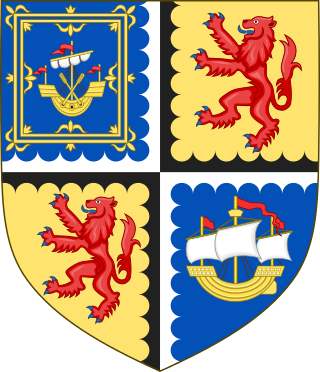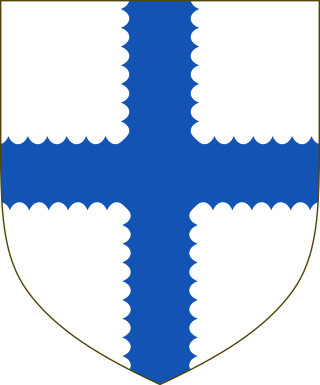Related Research Articles
William Sinclair (1410–1480), 1st Earl of Caithness (1455–1476), last Earl (Jarl) of Orkney, 2nd Lord Sinclair and 11th Baron of Roslin was a Norwegian and Scottish nobleman and the builder of Rosslyn Chapel, in Midlothian.

Earl of Orkney, historically Jarl of Orkney, is a title of nobility encompassing the archipelagoes of Orkney and Shetland, which comprise the Northern Isles of Scotland. Originally founded by Norse invaders, the status of the rulers of the Northern Isles as Norwegian vassals was formalised in 1195. Although the Old Norse term jarl is etymologically related to "earl", and the jarls were succeeded by earls in the late 15th century, a Norwegian jarl is not the same thing. In the Norse context the distinction between jarls and kings did not become significant until the late 11th century and the early jarls would therefore have had considerable independence of action until that time. The position of Jarl of Orkney was eventually the most senior rank in medieval Norway except for the king himself.

Earl of Caithness is a title that has been created several times in the Peerage of Scotland, and it has a very complex history. Its first grant, in the modern sense as to have been counted in strict lists of peerages, is now generally held to have taken place in favor of Maol Íosa V, Earl of Strathearn, in 1334, although in the true circumstances of 14th century, this presumably was just a recognition of his hereditary right to the ancient earldom/mormaership of Caithness. The next year, however, all of his titles were declared forfeit for treason.

Scalloway Castle is a tower house in Scalloway, on the Shetland Mainland, the largest island in the Shetland Islands of Scotland. The tower was built in 1600 by Patrick Stewart, 2nd Earl of Orkney, during his brief period as de facto ruler of Shetland.

Clan Gunn is a Highland Scottish clan associated with lands in northeastern Scotland, including Caithness, Sutherland and, arguably, the Orkney Isles. Clan Gunn is one of the oldest Scottish Clans, being descended from the Norse Jarls of Orkney and the Pictish Mormaers of Caithness.
Humans have inhabited Orkney, an archipelago in the north of Scotland, for about 8,800 years: Archeological evidence dates from Mesolithic times. Scandinavian clans dominated the area from the 8th century CE, using the islands as a base for further incursions. In the late 14th century the archipelago became part of Scotland.

St Magnus Cathedral dominates the skyline of Kirkwall, the main town of Orkney, a group of islands off the north coast of mainland Scotland. It is the oldest cathedral in Scotland, and the most northerly cathedral in the United Kingdom, a fine example of Romanesque architecture built for the bishops of Orkney when the islands were ruled by the Norse Earls of Orkney. It is owned not by the church, but by the burgh of Kirkwall as a result of an act of King James III of Scotland following Orkney's annexation by the Scottish Crown in 1468. It has its own dungeon.

The Earl's Palace is a ruined Renaissance-style palace near St Magnus's Cathedral in the centre of Kirkwall, Orkney, Scotland. Built by Patrick, Earl of Orkney, its construction began in 1607 and was largely undertaken via forced labour. Today, the ruins are open to the public.

The Bishop's Palace, Kirkwall is a 12th-century palace built at the same time as the adjacent St Magnus Cathedral in the centre of Kirkwall, Orkney, Scotland. It housed the cathedral's first bishop, William the Old of the Norwegian Catholic church who took his authority from the Archbishop of Nidaros (Trondheim). The ruined structure now looks like a small castle.

Clan Sinclair is a Highland Scottish clan which holds the lands of Caithness, the Orkney Islands, and the Lothians. The chiefs of the clan were the Barons of Roslin and later the Earls of Orkney and Earls of Caithness.

Patrick Stewart, Earl of Orkney, Lord of Zetland was a Scottish nobleman, the son of Robert, Earl of Orkney, a bastard son of King James V. Infamous for his godless nature and tyrannical rule over the Scottish archipelagos of Orkney and Shetland, he was executed for treason in 1615.

Braal Castle is located by the River Thurso north of the village of Halkirk, in Caithness, northern Scotland. The ruined castle, which dates back to the mid-14th century, was originally known as the Castle of Brathwell.

Clan Stewart is a Scottish Highland and Lowland clan. The clan is recognised by Court of the Lord Lyon; however, it does not have a Clan Chief recognised by the Lord Lyon King of Arms. Because the clan has no chief it can be considered an armigerous clan; however, the Earls of Galloway are now considered to be the principal branch of this clan, and the crest and motto of The Earls of Galloway's arms are used in the Clan Stewart crest badge. The Court of the Lord Lyon recognises two other Stewart/Stuart clans, Clan Stuart of Bute and Clan Stewart of Appin. Clan Stuart of Bute is the only one of the three clans at present which has a recognised chief.

James Law was Archbishop of Glasgow. Entering the church after graduation from university, he rose to the position of Bishop of Orkney, reorganising the diocese, before rising to hold the position of Archbishop of Glasgow.

Dingwall Castle was a medieval fort and royal castle in the town of Dingwall, eastern Ross-shire, Scotland.

The Battle of Summerdale was fought on 19 May 1529, and was the last battle to take place on Orkney soil. The battle took place on the boundary of the parishes of Orphir and Stenness in Mainland, Orkney. The battle was fought between the Sinclairs of Orkney and Shetland and the Sinclairs of Caithness, who had the support of James V, King of Scotland.

Sir Robert Gordon of Gordonstoun was a Scottish politician and courtier, known as the historian of the noble house of Sutherland.

George Sinclair was a Scottish nobleman, the 5th Earl of Caithness and chief of the Clan Sinclair, a Scottish clan based in northern Scotland.
John Gordon, 13th Earl of Sutherland (1576–1615) was a Scottish landowner and courtier.

William Sinclair was a Scottish nobleman and the 5th Lord Sinclair. In The Scots Peerage by James Balfour Paul he is designated as the 4th Lord Sinclair in descent starting from William Sinclair, 1st Earl of Caithness and 3rd Earl of Orkney, but historian Roland Saint-Clair designates him as the 5th Lord Sinclair in descent from the father of the 1st Earl of Caithness and 3rd Earl of Orkney, Henry II Sinclair, Earl of Orkney, who is the first person recorded as Lord Sinclair in public records. Roland Saint-Clair references this to an Act of the Scottish Parliament in which the 4th Lord Sinclair was made Lord Sinclair based on his descent from his great-grandfather, Henry II Sinclair, Earl of Orkney, the first Lord Sinclair. Bernard Burke, in his a Genealogical and Heraldic Dictionary of the Peerage and Baronetage of the British Empire, agrees with Roland Saint-Clair and says that William Sinclair was "in reality" the fifth Lord Sinclair.
References
- 1 2 3 "Kirkwall, Castle". CANMORE . Royal Commission on the Ancient and Historical Monuments of Scotland . Retrieved 5 August 2011.
- ↑ Mackintosh, John (1895). The history of civilisation in Scotland. Vol. 3. A. Gardner. p. 241.